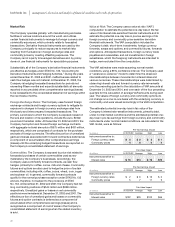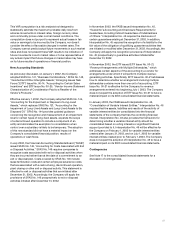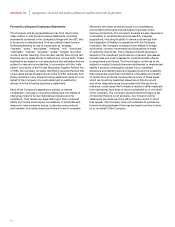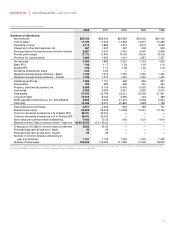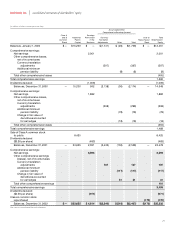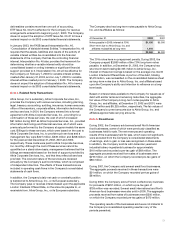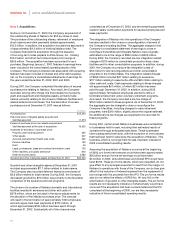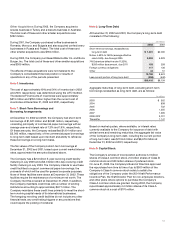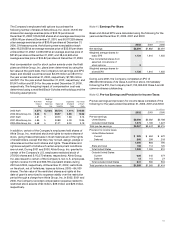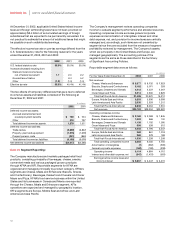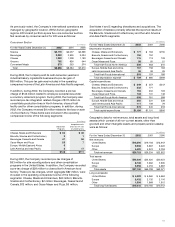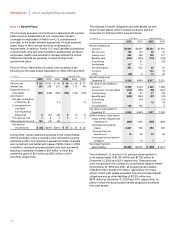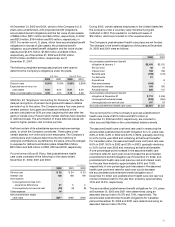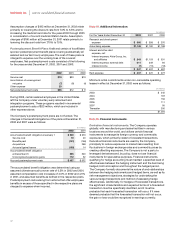Kraft 2002 Annual Report Download - page 54
Download and view the complete annual report
Please find page 54 of the 2002 Kraft annual report below. You can navigate through the pages in the report by either clicking on the pages listed below, or by using the keyword search tool below to find specific information within the annual report.
50
kraft foods inc. notes to consolidated financial statements
Income taxes: The Company accounts for income taxes in
accordance with SFAS No. 109, “Accounting for Income Taxes.”
The accounts of the Company are included in the consolidated
federal income tax return of Altria Group, Inc. Income taxes are
generally computed on a separate company basis. To the extent
that foreign tax credits, capital losses and other credits generated
by the Company, which cannot be utilized on a separate company
basis, are utilized in Altria Group, Inc.’s consolidated federal
income tax return, the benefit is recognized in the calculation of
the Company’s provision for income taxes. The Company utilized
tax benefits that it would otherwise not have been able to use of
$193 million, $185 million and $139 million for the years ended
December 31, 2002, 2001 and 2000, respectively. The Company
makes payments to, or is reimbursed by, Altria Group, Inc., for the
tax effects resulting from its inclusion in Altria Group, Inc.’s
consolidated federal income tax return.
Inventories: Inventories are stated at the lower of cost or market.
The last-in, first-out (“LIFO”) method is used to cost substantially
all domestic inventories. The cost of other inventories is
principally determined by the average cost method.
Marketing costs: The Company promotes its products with
significant marketing activities, including advertising, consumer
incentives and trade promotions. Advertising costs are expensed
as incurred. Consumer incentive and trade promotion activities
are recorded as a reduction of revenues based on amounts
estimated as being due to customers and consumers at the
end of a period, based principally on historical utilization and
redemption rates.
Revenue recognition: The Company recognizes revenues,
net of sales incentives and including shipping and handling
charges billed to customers, upon shipment of goods when title
and risk of loss pass to customers. Shipping and handling costs
are classified as part of cost of sales.
Effective January 1, 2002, the Company adopted the Emerging
Issues Task Force (“EITF”) Issue No. 00-14, “Accounting for
Certain Sales Incentives” and EITF Issue No. 00-25, “Vendor
Income Statement Characterization of Consideration Paid to a
Reseller of the Vendor’s Products.” Prior period consolidated
statements of earnings have been reclassified to reflect the
adoption. The adoption of these EITF Issues resulted in a
reduction of revenues of approximately $4.6 billion and
$3.6 billion in 2001 and 2000, respectively. In addition, the
adoption reduced marketing, administration and research costs
by $4.7 billion and $3.7 billion in 2001 and 2000, respectively,
while cost of sales increased by an insignificant amount. The
adoption of these EITF Issues had no impact on operating
income, net earnings or basic and diluted EPS.
Software costs: The Company capitalizes certain computer
software and software development costs incurred in connection
with developing or obtaining computer software for internal use.
Capitalized software costs are amortized on a straight-line basis
over the estimated useful lives of the software, which do not
exceed five years.
Stock-based compensation: The Company accounts for
employee stock compensation plans in accordance with the
intrinsic value-based method permitted by SFAS No. 123,
“Accounting for Stock-Based Compensation,” which did not
result in compensation cost for stock options.
At December 31, 2002, the Company had stock-based employee
compensation plans, which are described more fully in
Note 10. Stock Plans. The Company applies the recognition and
measurement principles of Accounting Principles Board Opinion
No. 25, “Accounting for Stock Issued to Employees,” and related
Interpretations in accounting for those plans. No compensation
expense for employee stock options is reflected in net earnings
as all options granted under those plans had an exercise price
equal to the market value of the common stock on the date of the
grant. Net earnings, as reported, includes compensation expense
related to restricted stock. The following table illustrates the effect
on net earnings and EPS if the Company had applied the fair
value recognition provisions of SFAS No. 123 to stock-based
employee compensation for the years ended December 31, 2002,
2001 and 2000:
(in millions, except per share data)
2002 2001 2000
Net earnings, as reported $3,394 $1,882 $2,001
Deduct:
Total stock-based employee
compensation expense determined
under fair value method for all
stock option awards, net of related
tax effects 78 97 54
Pro forma net earnings $3,316 $1,785 $1,947
Earnings per share:
Basic—as reported $1.96 $ 1.17 $ 1.38
Basic—pro forma $1.91 $ 1.11 $ 1.34
Diluted—as reported $1.96 $ 1.17 $ 1.38
Diluted—pro forma $1.91 $ 1.11 $ 1.34
New accounting pronouncements: In July 2002, the FASB
issued SFAS No. 146, “Accounting for Costs Associated with Exit
or Disposal Activities.” SFAS No. 146 requires companies to
recognize costs associated with exit or disposal activities when
they are incurred rather than at the date of a commitment to an
exit or disposal plan. Costs covered by SFAS No. 146 include
lease termination costs and certain employee severance costs
that are associated with a restructuring, discontinued operation,
plant closing or other exit or disposal activity. This statement is
effective for exit or disposal activities that are initiated after
December 31, 2002. Accordingly, the Company will apply the
provisions of SFAS No. 146 prospectively to exit or disposal
activities initiated after December 31, 2002.
In November 2002, the EITF issued EITF Issue No. 00-21,
“Revenue Arrangements with Multiple Deliverables,” which
addresses certain aspects of the accounting by a vendor for
arrangements under which it will perform multiple revenue-
generating activities. Specifically, EITF Issue No. 00-21 addresses
how to determine whether an arrangement involving multiple


